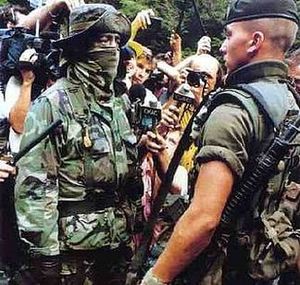Face to Face (photograph) facts for kids
Face to Face is a famous photograph from a time of conflict in Canada. It shows a Canadian soldier, Private Patrick Cloutier, and an Anishinaabe warrior, Brad Larocque, looking directly at each other. This powerful image was taken on September 1, 1990, by photographer Shaney Komulainen during the Oka Crisis. It has become one of Canada's most well-known pictures.
Contents
The Story Behind the Photo
Shaney Komulainen was a photographer working for The Canadian Press. On September 1, 1990, she was near Montreal, where the Mohawk had set up a blockade. This blockade was part of the Oka Crisis, a dispute over land.
Komulainen heard that the Canadian Army was moving into the area. She quickly got permission to go to "The Pines," which is where the famous photo was taken.
When she saw the soldier and the warrior face to face, she was struck by how young the soldier, Patrick Cloutier, looked. Several warriors approached Cloutier during this tense moment. In a video of the event, you can hear Larocque asking Cloutier if he was nervous. Komulainen remembers Larocque talking about what it felt like for a bullet to enter a body.
Cloutier, who spoke only French, did not understand what Larocque was saying in English. Komulainen took many photos of the two men. Her film was then quickly taken to Montreal to be developed and printed.
Meet Brad Larocque
Brad Larocque, also known by his nickname "Freddy Krueger," was a student at the University of Saskatchewan. He had traveled to Kanesatake earlier that summer to support the Mohawk people.
Even though his nickname came from a horror movie character, reporters knew Larocque as a quiet person. After the conflict, Larocque lived in Montreal for a while. He later moved back to Saskatchewan.
Who Was That Masked Man?
Because Brad Larocque wore a mask in the photo, some people mistakenly thought he was another warrior named Ronald "Lasagna" Cross. "Lasagna" (whose real name was Ronaldo Casalpro) had also been photographed in a similar face-to-face moment with a different soldier.
Meet Patrick Cloutier
Patrick Cloutier was a 19-year-old soldier from Saint-Maxime-du-Mont-Louis, Quebec. He was a private with the Royal 22e Régiment of the Canadian Army.
After the photo was published, many people saw Cloutier as a Canadian hero. News articles compared him to famous figures who stood up to powerful forces. Media in Quebec highlighted his "Quebecois roots." One newspaper described him as "the little soldier staring unblinkingly at the angry Warrior." Later that year, Cloutier received a faster promotion to master corporal.
Cloutier served in the Canadian military again during the Bosnian War. He later said that he never supported the reason for the conflict, which was about a golf course. He stated, "I was for the Indians! I spent a lot of time in Nunavut and with First Nations, they're my favourite people." As of 2015, he was working for the Canadian Coast Guard.
Meet Shaney Komulainen
Shaney Komulainen was 27 years old when she took the famous photograph. About eight months later, she was seriously injured in a car accident near Oka. She was working on a follow-up story at the time.
Komulainen suffered broken legs and brain injuries. These injuries meant she could no longer continue her career as a journalist. While she was still recovering in the hospital, she faced some legal issues related to the Oka Crisis. However, she was found not guilty of all charges in court.
The Photo's Lasting Impact
The Face to Face photo became the most recognized image of the Oka Crisis. Some experts say it is one of the most iconic Canadian photos ever taken. One photographer, Rob Galbraith, believes it is among the top five Canadian photos. He says it's powerful because "It’s the symbolism of it." He feels it's an image that doesn't need words to explain it.
However, Bill Grimshaw, who developed the photo, had a different view. He thought it was a "great photo for the day" but believed it was more like "theatre" and didn't truly explain the situation.
A study looked at how different Canadians reacted to the photograph. The study found that "People project onto this image what they want to see." This means people interpret the photo in ways that fit their own beliefs. For example, many non-Indigenous people saw the photo as a symbol of Canadian peacekeeping. However, this view might not fully capture the complex events of the Oka Crisis.
The image was even used by the Canadian forces to encourage people to join. The photograph still appears in Canadian news stories today, even when they are only partly related to the Oka Crisis. Indigenous activists also continue to use the photo to represent strength and resistance.


